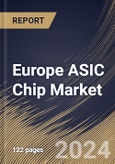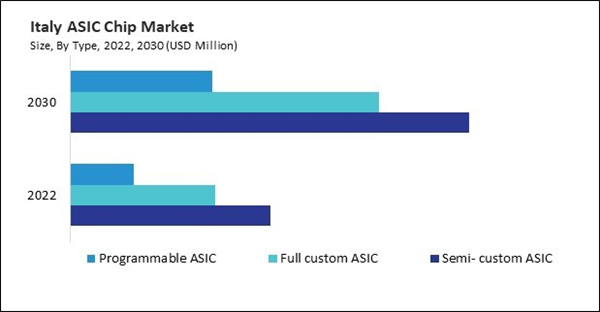The Germany market dominated the Europe ASIC Chip Market by Country in 2022, and would continue to be a dominant market till 2030; thereby, achieving a market value of $1,837.6 million by 2030. The UK market is exhibiting a CAGR of 6.6% during (2023 - 2030). Additionally, The France market would experience a CAGR of 8.5% during (2023 - 2030).
ASICs find applications in medical imaging devices, wearable health monitors, and diagnostic equipment in healthcare. As per the data released from the Indian Brand Equity Foundation, by 2030, the medical equipment industry in India is anticipated to reach a valuation of $50 billion by 2030. This industry has attracted substantial investments over time. In FY20, foreign investments in medical devices increased by 98% year-over-year to Rs. 2,196 crore (US$301.01 million). The customization capabilities of ASICs allow for the creation of specialized chips optimized for processing and analyzing medical data, thereby enhancing the performance and accuracy of healthcare technologies.
Furthermore, ASICs play a pivotal role in medical imaging technologies such as X-ray, magnetic resonance imaging (MRI), and computed tomography (CT) scans. Customizing ASICs allows for developing customized imaging processors tailored to each modality's unique requirements. These specialized chips enhance the efficiency of image acquisition, processing, and reconstruction, resulting in improved diagnostic accuracy and reduced radiation exposure for patients. As the healthcare sector expands across nations, there will be increased demand for ASIC chips. For example, as per the data from the Government of Australia, the country spent an estimated $241.3 billion on health goods and services in 2021-22 - an average of approximately $9,365 per person. Inflation-adjusted real growth in total health expenditures (recurrent and capital) was 6.0% higher than in 2020-21. This exceeded the ten-year average annual growth rate of 3.4% until 2021-22.
In addition, the growth of the aerospace sector in the UK contributes to an increased demand for ASICs in avionics applications. The aerospace industry places a strong emphasis on safety and reliability. ASICs designed for aerospace applications adhere to stringent standards and requirements, ensuring the reliability and performance needed for critical functions in aircraft systems. The defense industry achieved an approximate turnover of $29 billion in 2022, of which $15 billion was allocated for exports. Hence, Europe's growing aerospace and healthcare sectors can boost the demand for ASIC chips in the region.
Based on Type, the market is segmented into Semi- custom ASIC, Full custom ASIC, and Programmable ASIC. Based on End User, the market is segmented into Data Processing Systems, Telecommunication Systems, Aerospace Subsystem & Sensors, Consumer Electronics, Medical Instrumentation, and Others. Based on countries, the market is segmented into Germany, UK, France, Russia, Spain, Italy, and Rest of Europe.
List of Key Companies Profiled
- Advanced Micro Devices, Inc.
- Samsung Electronics Co., Ltd. (Samsung Group)
- ON Semiconductor Corporation
- Taiwan Semiconductor Manufacturing Company Limited
- NVIDIA Corporation
- Intel Corporation
- Infineon Technologies AG
- Texas Instruments, Inc.
- Seiko Epson Corporation
- BITMAIN Technologies Holding Company
Market Report Segmentation
By Type- Semi- custom ASIC
- Full custom ASIC
- Programmable ASIC
- Data Processing Systems
- Telecommunication Systems
- Aerospace Subsystem & Sensors
- Consumer Electronics
- Medical Instrumentation
- Others
- Germany
- UK
- France
- Russia
- Spain
- Italy
- Rest of Europe
Table of Contents
Companies Mentioned
- Advanced Micro Devices, Inc.
- Samsung Electronics Co., Ltd. (Samsung Group)
- ON Semiconductor Corporation
- Taiwan Semiconductor Manufacturing Company Limited
- NVIDIA Corporation
- Intel Corporation
- Infineon Technologies AG
- Texas Instruments, Inc.
- Seiko Epson Corporation
- BITMAIN Technologies Holding Company









